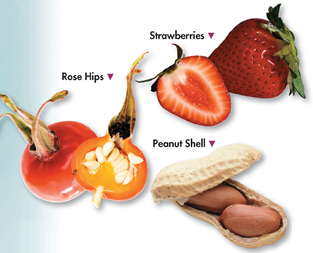24.2 Fruits and Seeds
 How do fruits form?
How do fruits form? How are seeds dispersed?
How are seeds dispersed? What factors influence the dormancy and germination of seeds?
What factors influence the dormancy and germination of seeds?
dormancy
germination
Flowchart Make a flowchart that shows the process of germination and the factors that influence it. Indicate the differences between monocots and dicots.
THINK ABOUT IT What are fruits, and what purpose do they serve for the plants that produce them? Would it surprise you to learn that if you ate a meal of corn on the cob and baked beans, from the point of view of a biologist, you were actually eating fruit? And have you ever wondered why plants go to the “trouble” of surrounding their seeds with tasty, fleshy fruits like those produced by apples, oranges, and grapes? Here's a hint: You, and all the animals that enjoy those fruits, are being used. Plants may be smarter than you think.
Seed and Fruit Development
 How do fruits form?
How do fruits form?
The development of the seed, which protects and nourishes the plant embryo, contributed greatly to the success of plants on land. The angiosperm seed, encased inside a fruit, was an even better adaptation. As you will see, by helping a seed get into the best possible location to start its new life, fruits were immediately favored by natural selection.
Once fertilization of an angiosperm is complete, nutrients flow into the flower tissue and support the development of the growing embryo within the seed.  As angiosperm seeds mature, ovary walls thicken to form a fruit that encloses the developing seeds. A fruit is simply a matured angiosperm ovary, usually containing seeds. An exception is found in commercially grown fruits that are selectively bred to be seedless, such as some varieties of grapes. Examples of fruits are shown in Figure 24–9.
As angiosperm seeds mature, ovary walls thicken to form a fruit that encloses the developing seeds. A fruit is simply a matured angiosperm ovary, usually containing seeds. An exception is found in commercially grown fruits that are selectively bred to be seedless, such as some varieties of grapes. Examples of fruits are shown in Figure 24–9.
The term fruit applies to the sweet things we usually think of as fruits, such as apples, grapes, and strawberries. However, foods such as peas, corn, beans, rice, cucumbers, and tomatoes, which we commonly call vegetables, are also fruits.
The ovary wall surrounding a simple fruit may be fleshy, as it is in grapes and tomatoes, or tough and dry, like the shell that surrounds peanuts. (The peanuts themselves are the seeds.)
 In Your Notebook Make a list of the first ten “vegetables” that come to mind and place a check mark next to ones you think are fruits. Explain why.
In Your Notebook Make a list of the first ten “vegetables” that come to mind and place a check mark next to ones you think are fruits. Explain why.

FIGURE 24–9 Variety Among Fruits Like the flowers from which they develop, fruits vary in structure. Observe Which example is a dry fruit?

Table of Contents
- Formulas and Equations
- Applying Formulas and Equations
- Mean, Median, and Mode
- Estimation
- Using Measurements in Calculations
- Effects of Measurement Errors
- Accuracy
- Precision
- Comparing Accuracy and Precision
- Significant Figures
- Calculating With Significant Figures
- Scientific Notation
- Calculating With Scientific Notation
- Dimensional Analysis
- Applying Dimensional Analysis




